Welcome to the wonderful world of gardening! If you’ve been longing to get your hands dirty and bring life to your backyard, it’s time to unleash your green thumb. Gardening can be a healthy and enjoyable hobby, and with a few helpful tips, anyone can develop a green thumb and create a thriving garden. Whether you’re a beginner or an experienced gardener, this article will provide you with valuable knowledge and insights to help you embark on your gardening journey.
Key Takeaways:
- Planning is essential for a successful garden, so it’s important to understand your climate, soil type, and sunlight exposure.
- Lettuce and tomatoes are recommended for beginners, as they are easy to grow and yield abundant harvests.
- Choosing the right plants for your environment and providing adequate water and sunlight are crucial for the health of your garden.
- Fertilizing at the right time and repotting when necessary are important for the continuous growth and vitality of your plants.
- Gardening is a fun and rewarding challenge that brings joy and a sense of accomplishment.
Now that you’re ready to dig in, let’s explore the essential gardening tips and tools you need for a successful gardening experience. Get ready to create a beautiful and thriving garden that will bring you joy and satisfaction!
Planning for Success: The Essential Gardening Tips
Before you start digging, take some time to plan your garden for success. These gardening tips will guide you through the process of creating a vibrant and thriving outdoor space.
First, familiarize yourself with your climate, soil type, and sunlight exposure. Understanding these factors will help you choose plants that are well-suited to your environment. For example, if you live in a hot and dry climate, drought-resistant plants like succulents and cacti may be a better choice than water-intensive flowers.
Next, consider the layout and design of your garden. Take into account the available space, the direction of sunlight, and any existing structures or elements that you want to incorporate. Create a rough sketch or use a garden planning tool to visualize how your garden will look.
Once you have a plan in place, it’s time to start selecting plants. Consider your gardening goals and preferences. Are you interested in growing vegetables, flowers, or a mix of both? Research the specific planting guide for each plant and determine when and how to sow the seeds or plant the seedlings. Keep in mind the needed spacing between plants to ensure proper growth and allow for easy maintenance.
Remember, gardening is a continuous learning process. Don’t be afraid to experiment and make adjustments along the way. With these essential gardening tips, you’ll be on your way to creating a beautiful and thriving garden that brings you joy and satisfaction.
Planning Checklist:
- Research your climate, soil type, and sunlight exposure
- Create a garden layout and design
- Select plants based on your gardening goals and preferences
- Refer to the planting guide for each plant
- Keep track of plant spacing and maintenance needs
Remember, a well-planned garden is the foundation for success. Happy gardening!
| Garden Tips | Gardening Ideas | Backyard Gardening |
|---|---|---|
| Plan your garden according to your climate, soil, and sunlight conditions. | Get creative with your garden design and incorporate elements that reflect your personal style. | Make the most of your backyard space by utilizing vertical gardening techniques and maximizing plant density. |
| Choose plants that are suitable for your environment and gardening goals. | Experiment with different gardening techniques, such as companion planting or raised beds. | Consider installing outdoor seating or a designated area for enjoying your garden. |
| Maintain a watering and fertilizing schedule to ensure the health and growth of your plants. | Explore unique plant varieties and incorporate them into your garden for added visual interest. | Create a welcoming environment for wildlife, such as birds and butterflies, by including native plants. |
“Gardening is the art that uses flowers and plants as paint, and the soil and sky as canvas.” – Elizabeth Murray

Digging In: Must-Have Garden Tools
To get the most out of your gardening experience, it’s important to have the right tools at your disposal. Here are the must-have garden tools that will help you dig in and get the job done.
| Garden Tool | Description |
|---|---|
| Shovel | A sturdy shovel is essential for digging holes, moving soil, and transplanting plants. Look for one with a comfortable grip and a durable blade. |
| Trowel | A trowel is a smaller hand tool that is perfect for planting seeds and small plants. Choose one with a sharp edge for easy digging. |
| Garden Fork | A garden fork is useful for breaking up compacted soil and removing weeds. Look for one with strong tines and a comfortable handle. |
| Pruners | Pruners are essential for trimming and shaping plants. Opt for a pair with a sharp blade and a comfortable grip for easy, precise cutting. |
Aside from these basic tools, there are a few other handy items that can make your gardening experience more enjoyable. A sturdy pair of gloves will protect your hands from thorns and rough surfaces, while a watering can or hose attachment will help you easily hydrate your plants.
Remember, investing in quality tools will ensure they last longer and make your gardening tasks easier. With these must-have garden tools by your side, you’ll be ready to tackle any gardening project and cultivate a beautiful and thriving garden.
Understanding Your Garden’s Needs: Climate, Soil, and Sunlight
Every garden is unique, and understanding its individual needs is the key to a successful gardening experience. Let’s explore how climate, soil, and sunlight can influence your plant choices and garden’s overall health.
When it comes to gardening, the first step is to consider the climate of your area. Different plants thrive in different climates, so it’s essential to choose varieties that are well-suited to your region. If you live in a hot and dry climate, drought-tolerant plants like cacti and succulents are ideal. For those in cooler climates, frost-tolerant plants such as pansies and kale are excellent choices.
In addition to climate, the type of soil in your garden is another crucial factor. Some plants prefer well-draining soil, while others thrive in moist or acidic soil. Conduct a soil test to determine its pH level and nutrient content. This will help you understand which plants will flourish in your soil and whether any amendments are needed to optimize the growing conditions.
Lastly, the amount of sunlight your garden receives is essential for plant growth. Some plants require full sun exposure, while others prefer partial or even full shade. Observe the patterns of sunlight in your garden throughout the day and choose plants accordingly. Leafy vegetables like lettuce and spinach can tolerate partial shade, while sun-loving flowers like marigolds and petunias thrive in full sun.
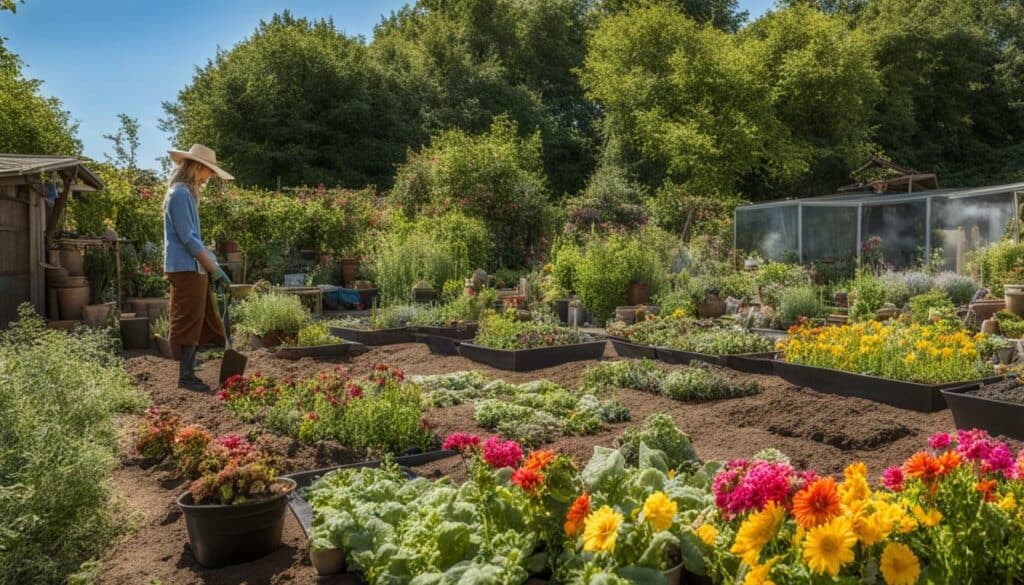
By taking into account the climate, soil, and sunlight conditions of your garden, you can make informed decisions about the plants you choose to cultivate. Understanding these factors will help ensure that your garden flourishes and provides you with a bountiful harvest or a beautiful outdoor space to enjoy.
| Climate | Soil Type | Sunlight Exposure |
|---|---|---|
| Hot and Dry | Well-draining | Full Sun |
| Cooler | Moist or Acidic | Partial Shade |
Remember, gardening is a continuous learning process, and experimenting with different plants and techniques can be part of the fun. Enjoy the journey of cultivating your garden and watch as it flourishes under your care!
Beginner’s Delight: Easy-to-Grow Plants for Your Garden
If you’re new to gardening, fear not! These easy-to-grow plants will give you a great head start on your gardening journey. Learn which vegetables and flowers are perfect for beginners.
When it comes to vegetable gardening, lettuce is a fantastic choice for beginners. It’s fast-growing and can be harvested in just a few weeks. Plus, there are many varieties to choose from, like crisphead, romaine, and leaf lettuce. Plant the seeds directly in the soil and keep it evenly moist. Harvest the outer leaves as needed, and your lettuce plants will continue to produce throughout the growing season.
Tomatoes are another excellent option for novice gardeners. They are versatile, productive, and incredibly rewarding. Choose determinate varieties like ‘Roma’ or ‘Celebrity’ for compact plants that are easier to manage. Start your tomatoes indoors from seeds, and once the danger of frost has passed, transplant them to a sunny spot in your garden. Provide support for the plants with stakes or cages and water them regularly. In no time, you’ll be enjoying delicious, homegrown tomatoes!
| Plant | Best for | Planting Time |
|---|---|---|
| Lettuce | Beginners, quick harvest | Spring, fall |
| Tomatoes | Beginners, bountiful harvest | Spring, after last frost |
As for flower gardens, marigolds are a fantastic choice for beginners. They are hardy, pest-resistant, and come in vibrant colors. Marigold seeds can be directly sown in the garden after the last frost. They prefer full sun and well-draining soil. With regular watering and deadheading, marigolds will bloom profusely and add a cheerful touch to your garden.
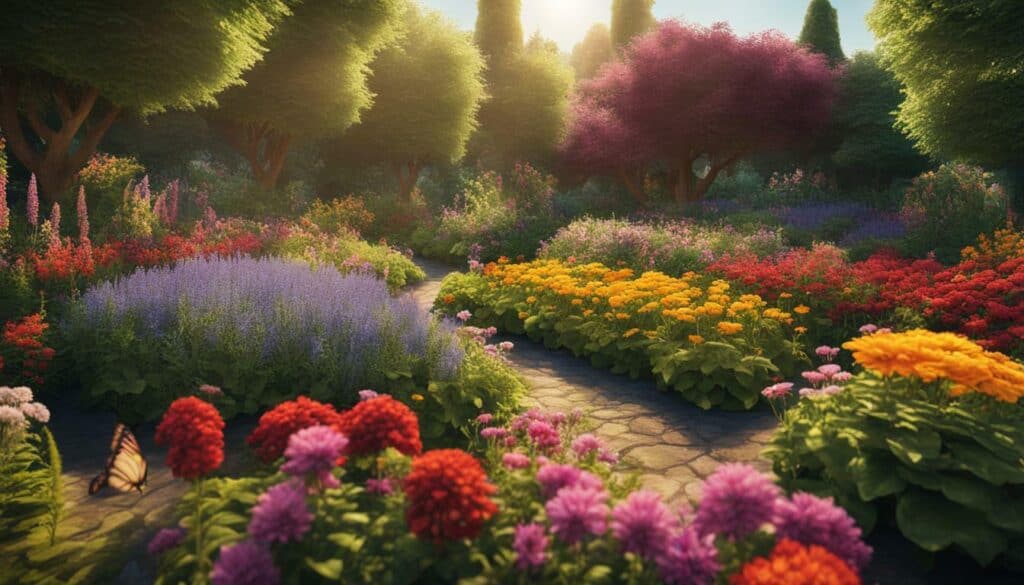
“Gardening is a natural way to feed both body and soul.” – Grace Heffernan Arnold
With these easy-to-grow plants, you’ll be well on your way to a thriving garden. Remember, gardening is a journey of learning and experimentation, so don’t be afraid to get your hands dirty and have fun along the way. Happy gardening!
Nurturing Your Garden: Watering, Sunlight, and Care
Your garden needs constant care and attention to thrive. Discover the best practices for watering, sunlight exposure, and general care to keep your plants happy and flourishing.
First and foremost, watering your plants properly is crucial for their health. Different plants have different water requirements, so it’s essential to research each plant’s specific needs. Generally, it’s better to water deeply and less frequently rather than shallowly and frequently. This encourages the roots to grow deeper into the soil, promoting stronger and more resilient plants.
When it comes to sunlight, it’s important to understand the needs of each plant. Some plants thrive in full sun, while others prefer partial shade. Make sure to position your pots or garden beds accordingly, taking into account the direction and intensity of the sunlight in your area. Observing your plants and monitoring any signs of sunburn or inadequate sunlight is key to maintaining their overall health.
General care routines play a significant role in the vitality of your garden. Regularly inspect your plants for signs of pests or diseases and take prompt action to prevent their spread. Pruning dead or damaged leaves and flowers not only enhances the appearance of your garden but also directs the plant’s energy towards healthy growth. Remember to remove weeds regularly, as they compete with your plants for nutrients and resources.
| Garden Care Checklist |
|---|
| Proper watering techniques |
| Understanding sunlight requirements |
| Regular inspection for pests and diseases |
| Pruning dead or damaged leaves and flowers |
| Weed removal |
By following these watering, sunlight, and general care practices, you can create an environment that nurtures your plants and helps them thrive. With patience and dedication, you’ll be rewarded with a healthy and vibrant garden that brings you joy and beauty throughout the seasons.
Remember:
- Research the specific watering needs of each plant.
- Position your plants according to their sunlight requirements.
- Regularly inspect and care for your plants to prevent pests and diseases.
- Prune dead or damaged leaves and flowers to promote healthy growth.
- Keep your garden free from weeds to minimize competition for nutrients.
“The care you give your garden reflects in the beauty of its blooms.”
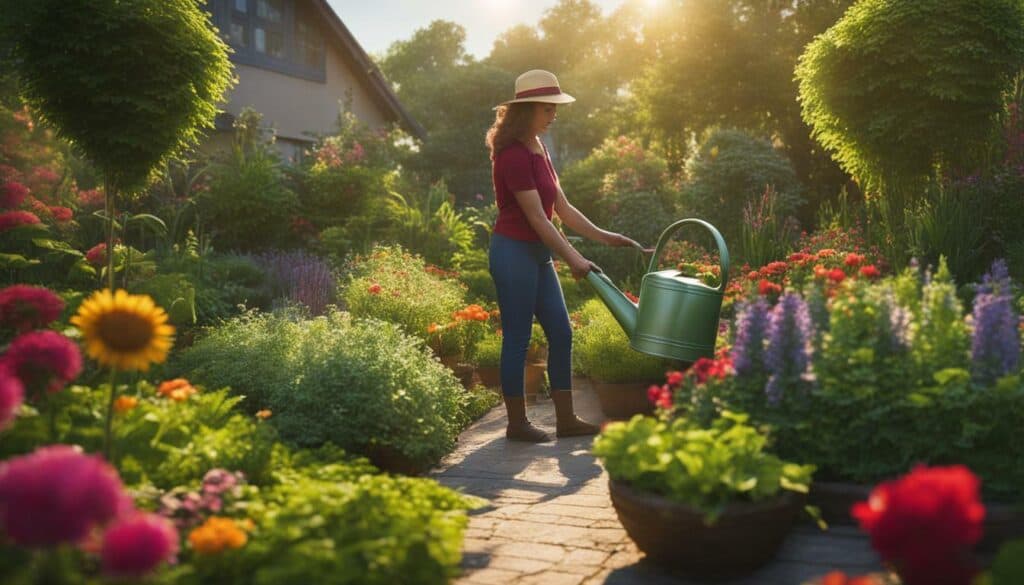
Feeding Your Garden: Fertilizing for Optimal Growth
Just like us, plants need proper nutrition to grow and thrive. Find out how to feed your garden by fertilizing it with the right nutrients at the right time.
One of the key elements of garden care is ensuring that your plants receive the necessary nutrients for optimal growth. Fertilizing your garden provides plants with the essential vitamins, minerals, and organic matter they need to flourish. By supplying the right balance of nutrients, you can enhance root development, encourage strong stems, promote vibrant foliage, and stimulate abundant flowering.
When it comes to fertilizing, timing is crucial. Different plants have varying nutrient requirements at different stages of their growth. It’s important to follow a feeding schedule that aligns with the specific needs of your plants. For example, nitrogen-rich fertilizers are best applied during the early stages of growth to promote leafy development, while phosphorus-rich fertilizers can be added during blooming to enhance flower production.
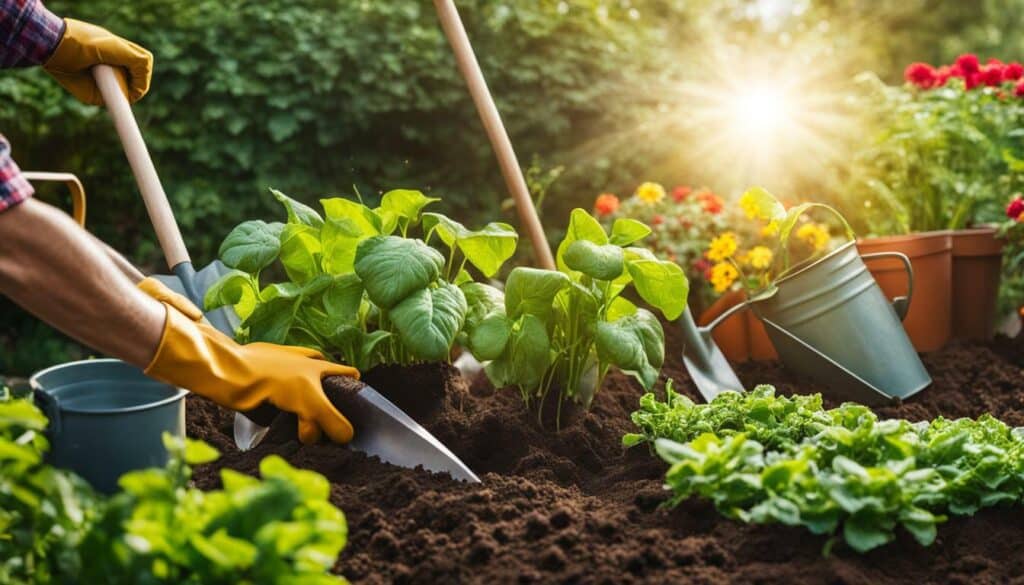
Before fertilizing, it’s essential to check the nutrient levels in your soil. This can be done through soil testing kits or by sending a sample to a professional laboratory. The results will help you determine which nutrients your garden may be lacking and allow you to choose the appropriate fertilizer to address any deficiencies.
| Fertilizer Type | Common Uses |
|---|---|
| Organic Fertilizer | Improves soil quality, enhances long-term plant growth |
| Water-Soluble Fertilizer | Provides quick and immediate nutrient uptake |
| Synthetic Fertilizer | Offers precise control over nutrient levels |
When applying fertilizer, it’s crucial to follow the instructions provided by the manufacturer. Over-fertilizing can lead to burning or damaging your plants, while under-fertilizing may result in nutrient deficiencies. Always remember to water your garden thoroughly after fertilizing to ensure the nutrients penetrate the soil and reach the plant’s roots.
Feeding your garden with the right nutrients through proper fertilization is an essential part of garden care. By understanding your plant’s nutrient requirements and following a consistent fertilizing routine, you can create an environment that promotes healthy growth, vibrant colors, and abundant harvests.
Repotting and Renewing: Giving Your Plants Room to Grow
As your plants grow, they’ll need more space to spread their roots and flourish. Learn how to give your plants room to grow by repotting them when necessary.
Repotting is an essential part of garden care that allows your plants to continue thriving in larger containers. It gives their roots more room to stretch out, access nutrients, and establish a stronger foundation. By repotting, you can ensure the long-term health and vitality of your plants.
When selecting a new pot, choose one that is slightly larger than the current container, allowing for adequate root expansion. Fill the new pot with well-draining potting soil, ensuring it’s fresh and nutrient-rich. Gently remove the plant from its original container, being careful not to damage the roots.
Place the plant in the center of the new pot and fill in the gaps with additional soil, firmly pressing it around the roots. Water the plant thoroughly to help settle the soil and provide hydration. Finally, place your repotted plant in a suitable location with proper sunlight and continue to care for it as needed.
Table: Steps to Repotting Your Plants
| Step | Description |
|---|---|
| 1 | Select a slightly larger pot |
| 2 | Fill the new pot with well-draining potting soil |
| 3 | Gently remove the plant from its original container |
| 4 | Place the plant in the center of the new pot |
| 5 | Fill the gaps with additional soil and water thoroughly |
| 6 | Ensure proper sunlight and continue regular care |
Remember to repot your plants when you notice signs of overgrowth, such as roots becoming densely packed or protruding from the bottom of the container. Repotting is also a great opportunity to refresh the soil and remove any diseased or damaged roots, promoting overall plant health.
Photograph your newly repotted plants to track their growth and progress. It’s incredibly rewarding to compare before and after photos and see how much your plants have thrived under your care. Enjoy the satisfaction of providing your plants with the optimal environment they need to flourish.
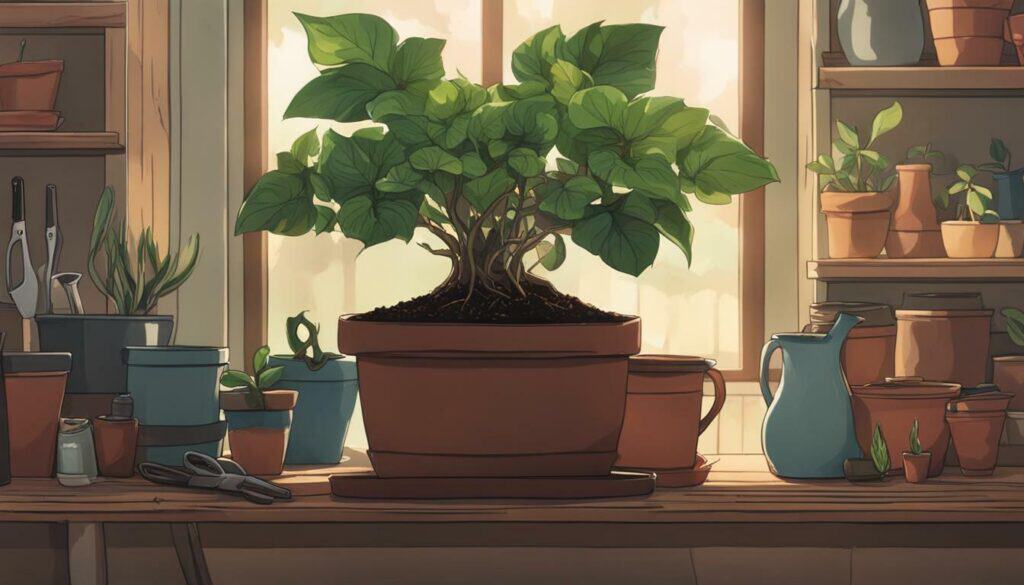
By following proper repotting techniques, you can ensure your plants have the space they need to grow and thrive. This essential garden care practice will help you maintain healthy and vibrant plants, allowing your garden to flourish with beauty and abundance.
The Thrill of Gardening: Fun and Rewarding Challenges
Gardening is more than just a hobby—it’s a thrilling adventure that offers endless opportunities for personal growth and fulfillment. Discover the joy and rewards that come with cultivating your own piece of nature. Whether you have a spacious backyard or a small balcony, gardening allows you to create a beautiful and vibrant space that reflects your unique personality and style.
As you embark on your gardening journey, you’ll find that it presents exciting challenges that keep you engaged and eager to learn. From selecting the right plants for your environment to mastering the art of nurturing and caring for them, each step of the gardening process comes with its own set of rewards and accomplishments. Watching seeds sprout, witnessing vibrant flowers blossom, and harvesting your own fresh veggies are moments that fill your heart with pride and satisfaction.
| Gardening Ideas |
|---|
| 1. Create a themed garden, such as a butterfly garden or a herb garden, to add a touch of whimsy and purpose to your space. |
| 2. Experiment with different plant combinations and textures to create visually stunning displays that are a feast for the eyes. |
| 3. Incorporate eco-friendly practices into your gardening routine, such as composting and using organic pest control methods, to contribute to a greener planet. |
| 4. Share your gardening adventures with others by organizing community gardening events or participating in local gardening clubs. |
Furthermore, gardening provides numerous health benefits. Spending time outdoors, working with soil, and being surrounded by nature have been shown to reduce stress, improve mental clarity, and boost overall well-being. The physical activity involved in gardening also keeps you active and promotes a healthy lifestyle.
So, why not take up the challenge and start your own garden today? With a little patience, a thirst for knowledge, and a willingness to get your hands dirty, you’ll be amazed at what you can achieve. Nurture your garden with love, and it will reward you with beauty, tranquility, and a sense of fulfillment that only nature can provide.
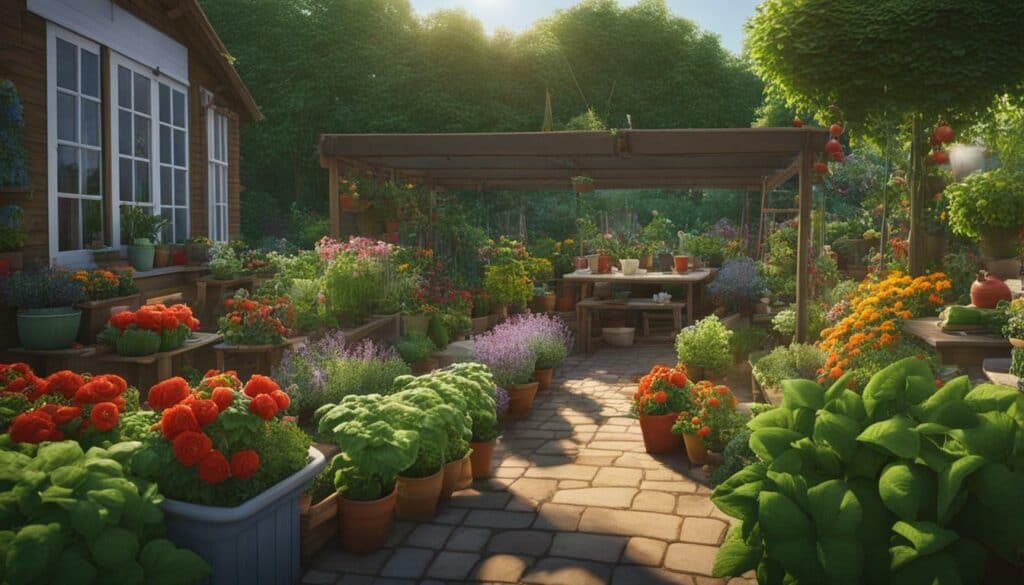
Growing a Beautiful Landscape: Adding Beauty to Your Garden
Your garden is a canvas waiting to be transformed into a breathtaking landscape. Unleash your creativity and learn how to design a garden that will leave everyone in awe. Whether you have a small backyard or a sprawling space, there are landscaping tips that can help you create a stunning outdoor oasis.
To begin, consider the layout of your garden. Think about how you want to use the space and what elements you want to incorporate. Do you envision a peaceful retreat with a cozy seating area? Or perhaps you want to showcase vibrant flowers and lush greenery? By having a clear vision of your desired outcome, you can plan your landscaping accordingly.
One effective way to add beauty to your garden is by incorporating different levels. This can be achieved by using raised beds, terraces, or even adding a pergola or archway. These structures not only create visual interest but also provide a sense of depth and dimension to your garden.

To add color and texture, choose a variety of plants with different heights, shapes, and foliage. Consider the blooming seasons of flowers and select a mix of perennials and annuals to ensure year-round beauty. Don’t forget to include evergreen plants for structure and to provide visual interest during the colder months.
Creating pathways or walkways adds functionality and elegance to your garden. Use natural materials such as stone or gravel to define the pathways, and surround them with plants or low-growing groundcover for a seamless transition.
Lastly, don’t underestimate the impact of lighting in your garden. Well-placed landscape lighting can highlight focal points, create ambiance, and extend the usability of your outdoor space into the evening hours.
By considering these landscaping tips, you can transform your garden into a stunning masterpiece that captivates the senses and provides a tranquil haven for relaxation and enjoyment. Let your imagination run wild and create a garden that reflects your personal style and brings you endless joy.
| Landscaping Tips | |
|---|---|
| 1. Have a clear vision for your garden | |
| 2. Incorporate different levels for visual interest | |
| 3. Choose a variety of plants for color and texture | |
| 4. Create pathways or walkways for functionality and elegance | |
| 5. Use landscape lighting to highlight focal points |
Enjoying the Fruits of Your Labor: Harvesting and Enjoying Your Garden’s Bounty
After weeks of nurturing your garden, it’s finally time to enjoy the bountiful harvest. Learn the art of harvesting and savor the delicious and beautiful rewards of your garden.
As a vegetable gardener, one of the most satisfying moments is picking your homegrown produce straight from the garden. Whether it’s plump tomatoes, crisp lettuce, or vibrant bell peppers, harvesting your own vegetables is a gratifying experience. Remember to harvest your vegetables when they are at their peak ripeness, ensuring maximum flavor and nutritional value.
When it comes to the flower garden, picking your own flowers can brighten up any space and bring a sense of joy. Whether you’re creating a stunning floral arrangement for your home or gifting a bouquet to a loved one, the possibilities are endless. When harvesting flowers, do so in the morning when the blooms are fresh and hydrated. Cut the stems at a slant, place them in a bucket of water, and let them hydrate before arranging them in a vase.
Harvesting Tips: Vegetable Gardening
Each vegetable has its own specific harvesting requirements, so let’s take a closer look at some popular choices:
| Vegetable | Harvesting Tips |
|---|---|
| Tomatoes | Harvest when the fruit is firm and fully colored. Hold the stem and gently twist to detach from the vine. |
| Lettuce | Harvest the outer leaves when they reach the desired size. Leave the inner leaves to continue growing. |
| Bell Peppers | Wait until the peppers are fully mature and have turned their vibrant color. Use sharp scissors or pruning shears to cut them from the plant. |
Remember, the joy of gardening extends beyond the harvest. Take a moment to appreciate the beauty and fragrance of your flowers, and savor the flavors of your homegrown vegetables. Gardening is a labor of love, and the rewards are truly fulfilling.
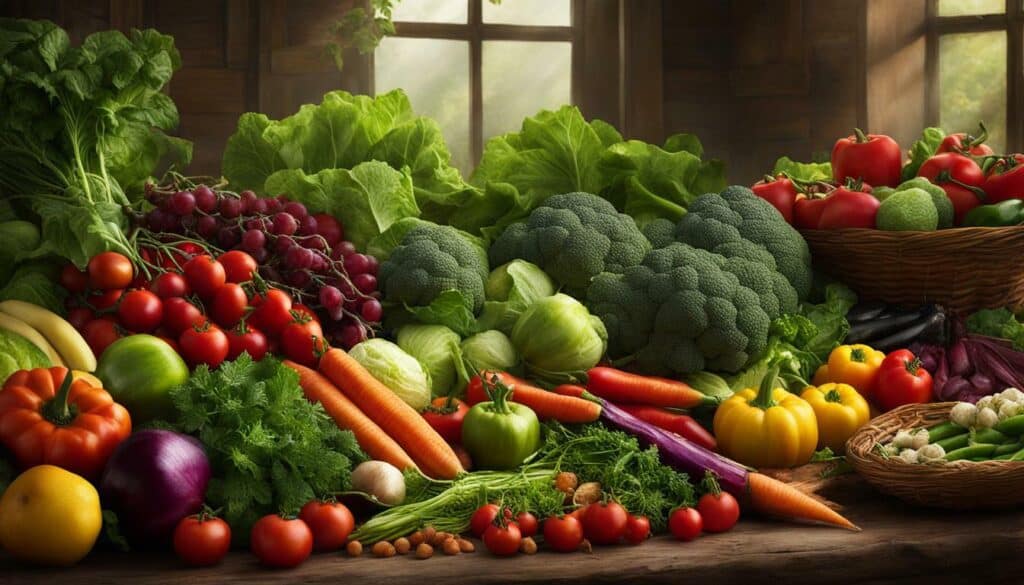
So, put on your gardening gloves, grab a basket, and embark on a journey of harvesting and enjoying the fruits of your labor. There’s nothing quite like the satisfaction of growing your own food and surrounding yourself with nature’s beauty.
Conclusion
Gardening is a journey of growth, both for your plants and for yourself. Take the plunge, enjoy the process, and watch your green thumb blossom as you create your own little piece of paradise.
Planning is key to success in gardening. Knowing your climate, soil type, and sunlight exposure will help you choose the right plants for your garden. Whether you have a spacious backyard or a small balcony, there are options for everyone to get their hands dirty and experience the joy of watching plants thrive.
For beginners, start with easy-to-grow plants like lettuce and tomatoes. These versatile plants are perfect for novice gardeners and will reward you with abundant harvests. Don’t forget to provide them with the right amount of water and sunlight, and watch them flourish under your care.
Fertilizing your garden at the right time and repotting when necessary are important steps in maintaining the health and growth of your plants. By nourishing them with the right nutrients and giving them the space they need to grow, you’ll be amazed at the vibrant and beautiful garden you can create.
Gardening is not just about the end result, it’s about the journey. It’s a rewarding and fulfilling hobby that can bring you immense joy and a sense of accomplishment. So step outside, connect with nature, and nurture your garden. Your efforts will be rewarded with a thriving oasis that you can proudly call your own.
What Are the Modern Reasons for Gardening?
Exploring the passion of modern gardening has become a popular trend due to several reasons. With the rise of urbanization and the need for green spaces, gardening offers a way to reconnect with nature. Additionally, people embrace gardening as a stress-reliever, a creative outlet, and a means to cultivate their own fresh produce. Moreover, sustainable living and environmental consciousness play a significant role in the modern appeal of gardening.
FAQ
Q: Can anyone develop a green thumb and become a successful gardener?
A: Yes, gardening is a hobby that anyone can enjoy and excel at with a little practice and knowledge. By following the right gardening tips and techniques, anyone can develop a green thumb and have a thriving garden.
Q: How do I determine which plants will thrive in my garden?
A: It’s important to know your climate, soil type, and sunlight exposure to determine which plants will thrive in your garden. By understanding these factors, you can choose plants that are well-suited to your environment and ensure their success.
Q: What are some easy-to-grow plants for beginners?
A: Lettuce and tomatoes are excellent choices for beginners, as they are easy to grow and provide bountiful harvests. These plants are relatively low-maintenance and can be grown in containers or in the ground.
Q: How often should I water my garden?
A: The frequency of watering depends on several factors, including the type of plant, soil moisture, and weather conditions. Generally, it’s best to water deeply and less frequently to encourage deep root growth. Regularly check the moisture level of the soil to determine when watering is necessary.
Q: When should I fertilize my plants?
A: Fertilizing should be done at the right time, depending on the specific needs of your plants. Generally, it’s best to fertilize in early spring before new growth begins and again in mid to late summer. Be sure to follow the instructions on the fertilizer package for the best results.
Q: How do I repot my plants?
A: Repotting is necessary when plants outgrow their containers. To repot, gently remove the plant from its current container, loosen the roots, and place it in a slightly larger pot with fresh potting soil. Be careful not to damage the roots during the process.
Q: Is gardening a rewarding hobby?
A: Yes, gardening is a fun and rewarding hobby that brings joy and a sense of accomplishment. Watching your plants grow and thrive, and being able to harvest the fruits of your labor is a truly satisfying experience.





Leave a Reply